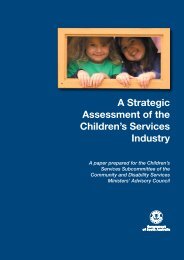Global Study On Child Poverty And Disparities (PDF) - Social Policy ...
Global Study On Child Poverty And Disparities (PDF) - Social Policy ...
Global Study On Child Poverty And Disparities (PDF) - Social Policy ...
Create successful ePaper yourself
Turn your PDF publications into a flip-book with our unique Google optimized e-Paper software.
issues affecting children in Vanuatu. This policy<br />
is accompanied by the Monitoring and Evaluation<br />
Framework for the Vanuatu <strong>Child</strong>ren’s <strong>Policy</strong><br />
2007–2011 (Government of Vanuatu 2008a),<br />
which was established to assist the National<br />
<strong>Child</strong>ren’s Coordination Committee to monitor the<br />
implementation of the <strong>Child</strong>ren’s <strong>Policy</strong>.<br />
Nutrition<br />
Adequate and appropriate feeding plays an<br />
important role in the optimal growth of children.<br />
Inadequate and inappropriate breastfeeding<br />
and complementary feeding practices can lead<br />
to poor health and malnutrition among children,<br />
which hinders their proper physical and mental<br />
development (MICS 2007).<br />
National laws, policies and<br />
programmes<br />
The relevant policies in this field are the Nutrition<br />
<strong>Policy</strong> (1986, updated 2005) and Breastfeeding<br />
<strong>Policy</strong> (1997, updated 2005). High-level<br />
government policies such as the PAA and even<br />
the Vanuatu Ministry of Health’s Health Sector<br />
<strong>Policy</strong> (2009-2015) do not mention child nutrition<br />
as a specific goal. A policy focus on child nutrition<br />
may well be intended as part of the overall goals<br />
of equitable health access and the focus on quality<br />
primary health care, but the absence of a specific<br />
child nutrition priority may be a disadvantage.<br />
The National <strong>Child</strong>ren’s <strong>Policy</strong> explicitly articulates<br />
the goal of strengthening existing health policies,<br />
including food and nutrition policy, breastfeeding<br />
and Expanded Programme of Immunization (EPI)<br />
policies and other relevant policies, protocols and<br />
procedures that could improve children’s health,<br />
nutrition and well-being. The Monitoring and<br />
Evaluation Framework of the National <strong>Child</strong>ren’s<br />
<strong>Policy</strong> calls for the nutrition and breastfeeding<br />
policies to be updated by 2011. It also proposes<br />
by 2011 to update and integrate the nutrition<br />
component of the school health curriculum in<br />
both the formal and non-formal sectors and the<br />
co-ordination and strengthening of integrated<br />
food and nutrition programmes at the provincial<br />
and national levels within the Government<br />
(Government of Vanuatu 2007b).<br />
Additional targets include the supply of safe and<br />
potable water in 70 per cent of schools by 2011<br />
(at present, only 47 per cent of primary schools<br />
have access to piped water (Ministry of Education,<br />
2007), and to improve health staff and children’s<br />
knowledge and skills on nutrition through<br />
education programs and materials.<br />
<strong>Child</strong> outcomes, disparities and<br />
gender equality<br />
Table 3.1 shows that national nutrition outcomes in<br />
Vanuatu have considerable room for improvement.<br />
While the percentage of children who are severely<br />
undernourished (more than 3 standard deviations<br />
below the international reference population) is<br />
not high, the percentage experiencing moderate<br />
malnourishment (2 or more standard deviations<br />
below the international reference population) is<br />
much higher, with 20 per cent of children less<br />
than five years old moderately stunted, 16 per<br />
cent moderately underweight and 6.5 per cent<br />
moderately wasted (Figure 3.1).<br />
Figure 3.1: <strong>Child</strong>ren age 0-59 months who are<br />
severely or moderately undernourished (%)<br />
25<br />
20<br />
15<br />
10<br />
5<br />
0<br />
6.8<br />
20.1<br />
Source: MICS 2007.<br />
Severe<br />
Moderate<br />
2.2 1.3<br />
Stunting Underweight Wasting<br />
Stunting is the worst of the nutrition outcomes,<br />
with nearly 7 per cent of all children severely<br />
stunted and 20 per cent moderately. Torba<br />
and Sanma are the regions with the highest<br />
percentage of severely underweight children (4<br />
per cent in each region); Port Vila and Sanma<br />
have the highest percentage of severely stunted<br />
children (9 per cent and 10 per cent, respectively),<br />
and Port Vila and Penama have the highest<br />
percentage of severely wasted children (3 per<br />
cent each), followed by Sanma with 2 per cent.<br />
Differences are most marked in relation to<br />
mother’s education, with much better nutrition<br />
outcomes for children with mothers who are better<br />
educated, by a ratio of up to two to one. There<br />
appears to be no consistent pattern of differences<br />
by wealth quintiles.<br />
15.9<br />
6.5<br />
54
















